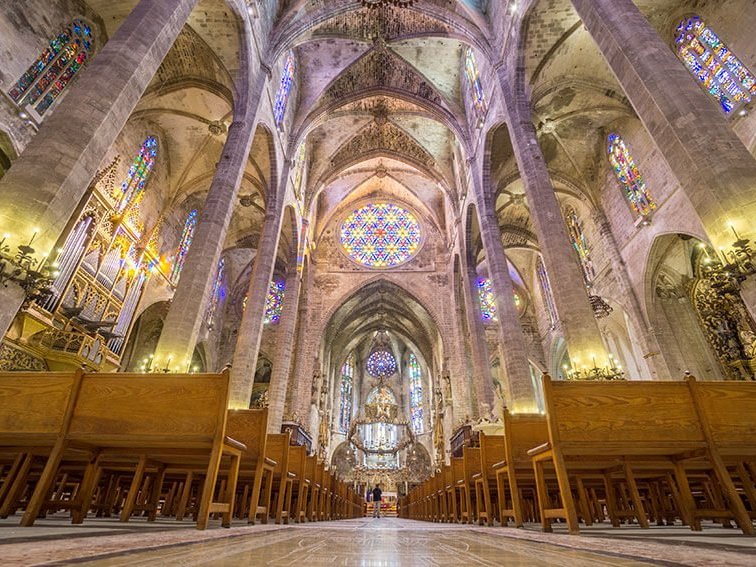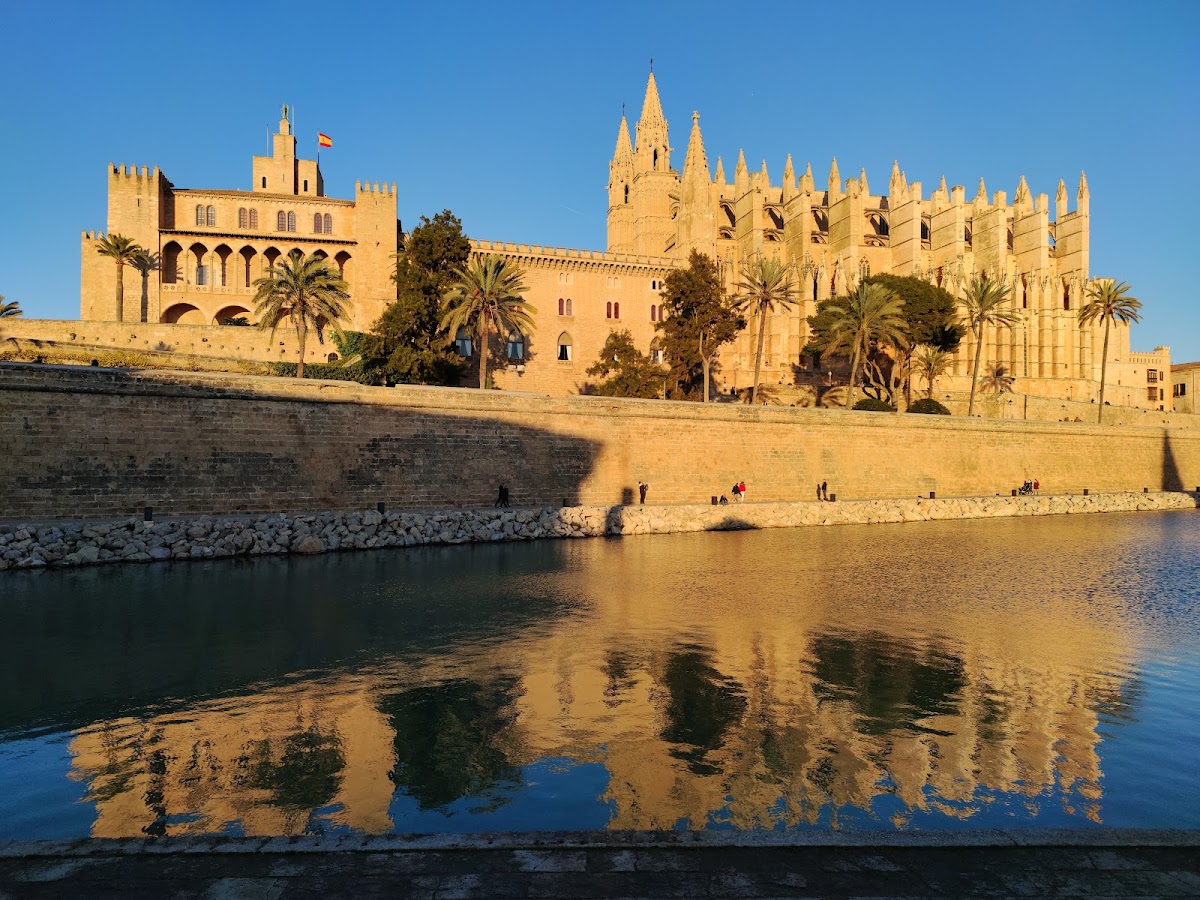Inside Palma Cathedral: A Gothic Marvel in Mallorca
The interior of Palma Cathedral, known as La Seu, is a breathtaking space that tells a layered story of centuries of architectural ambition, artistic expression, and liturgical evolution. While its majestic exterior dominates the Palma skyline, stepping inside reveals an intricate world of light, scale, and diverse artistic interventions.
Gothic Grandeur: The Foundation of Light and Height (13th - 16th Centuries)
The core of Palma Cathedral's interior is a magnificent example of Mediterranean Gothic architecture. King James I of Aragon ordered its construction in 1229, immediately after the conquest of Mallorca from the Moors, on the site of the former Great Mosque. This act symbolized the island's new Christian identity.
Construction began in earnest under James II around 1300, starting with the Royal Chapel (Capella Reial) at the eastern end, intended as a mausoleum for the Mallorcan monarchs (James II and James III are interred here). The cathedral was built over several centuries, culminating in its consecration in 1601.

Palma Cathedral, known as La Seu
Key Gothic features inside include:
- Immense Scale and Height: La Seu is renowned for its extraordinary dimensions. Its central nave soars to a remarkable 44 meters (144 feet), making it one of the tallest Gothic naves in Europe (only surpassed by Beauvais and Milan). This immense height, combined with slender, octagonal pillars, creates an awe-inspiring sense of verticality and spaciousness.
- The "Cathedral of Light": One of the most striking aspects is the abundant natural light. The cathedral is bathed in light thanks to its 87 large windows and seven rose windows. The most famous of these is the Great Rose Window, often called "The Gothic Eye." Located above the high altar in the chevet, it measures nearly 14 meters (46 feet) in diameter and is composed of 1,236 pieces of stained glass, making it one of the largest Gothic rose windows in the world. Twice a year (on February 2nd and November 11th), a unique phenomenon occurs where the morning sun projects the image of the Great Rose Window onto the opposite wall, creating a stunning "figure of eight" or "double rose window" effect.
- Three Naves: The interior features three parallel naves of varying heights, a characteristic often attributed to German Gothic influence that was adopted in Mediterranean Gothic architecture. Unlike many Gothic cathedrals, it does not have a transept or ambulatory, creating a vast rectangular space.
- Side Chapels: Lining the side naves are 16 chapels, each a testament to different periods and artistic styles that evolved in Mallorca over the centuries. They house various altarpieces, paintings, and sculptures, ranging from Gothic to Renaissance and Baroque.
Baroque Flourishes and 19th Century Restoration (17th - 19th Centuries)
As the centuries progressed, the interior saw the introduction of Baroque elements in the 17th and 18th centuries. This included ornate altarpieces, paintings, and sculptures that reflected the Counter-Reformation's emphasis on dramatic and emotional religious art. Notable examples include the Corpus Christi altarpiece.
The cathedral suffered structural damage over time, notably from an earthquake in 1851. This necessitated a major restoration in the 19th century, which saw the reconstruction of the main façade in a Neo-Gothic style. While the focus was on structural integrity, this period also influenced some interior detailing.
Gaudí's Modernist Intervention (Early 20th Century)
One of the most significant and transformative interventions in the interior of Palma Cathedral came from the renowned Catalan Modernist architect Antoni Gaudí. Commissioned by Bishop Pere Joan Campins, Gaudí worked on the cathedral between 1904 and 1915, aiming to adapt the space for contemporary liturgical practices and improve visibility for the congregation.
Gaudí's key contributions included:
- Relocation of the Choir: He controversially moved the central choir stalls (exquisite 15th-century Catalan Gothic woodwork) from the middle of the main nave to the presbytery, flanking the main altar. This opened up the central space of the nave for the faithful.
- New Furnishings and Lighting: He designed new furniture, ceramic panels with heraldic motifs, and monumental wrought-iron candelabras that ring the columns. He also reopened bricked-up windows to allow more natural light to flood the interior.
- The Baldachin: Perhaps his most striking (and initially controversial) addition is the massive heptagonal baldachin suspended above the main altar. Made of iron, cardboard, and cork, it is topped by a sculpture of a crucified Christ, surrounded by the Virgin and Saint John. While often described as a "Crown of Thorns," it reflects Gaudí's unique vision and modernist aesthetic. His ambitious plans were left incomplete due to disputes, but his influence on the current appearance of the presbytery is undeniable.
Contemporary Art: Miquel Barceló's Chapel (21st Century)
Adding another compelling layer to the cathedral's rich history is the intervention of contemporary Mallorcan artist Miquel Barceló. Between 2001 and 2006, Barceló transformed the Chapel of the Blessed Sacrament (or Sant Pere chapel) in the right-hand apse.
His monumental work, inaugurated in 2007, is a striking departure from the traditional aesthetic:
- Ceramic Mural: The entire apse of the chapel is covered in a vast, undulating polychrome ceramic mural. It depicts the biblical miracle of the loaves and fishes, but in a highly contemporary and often unsettling style, incorporating marine elements, fish, bread, fruit, and even human skulls.
- Unique Technique and Symbolism: Barceló employed the trencadís technique (compositions made from broken ceramic fragments), famously associated with Gaudí, but adapted it to his own distinctive style. The work evokes the bottom of the sea, connecting the miracle to Mallorca's deep relationship with the Mediterranean.
- Integrated Design: Barceló also designed new stone furniture for the chapel and created grisaille stained-glass windows that complement the mural's dramatic atmosphere.
The interior of Palma Cathedral is thus a living monument, a testament to centuries of artistic and architectural evolution. From its soaring Gothic vaults and radiant rose windows to Gaudí's modernist touches and Barceló's contemporary masterpiece, it offers visitors a profound and multifaceted journey through the history of faith, art, and the island of Mallorca.
The Cathedral of Santa Maria of Palma, more commonly known as Palma Cathedral or La Seu, is a stunning example of Gothic architecture that graces the skyline of Mallorca's capital. With its intricate design, soaring ceilings, and vibrant stained glass windows, the cathedral is a must-visit when exploring the island. Join us as we delve into the magnificent interiors of this iconic landmark.
The cathedral is open to visitors year-round. Visit during the early morning or late afternoon to fully appreciate its beauty, when sunlight streams through the rose window, casting colorful patterns across the floor and walls.
- Visitor Schedule: The cathedral is open Monday to Friday from 10:00 AM to 5:15 PM, and on Saturdays from 10:00 AM to 2:15 PM.
- Mass Schedule: Attending a mass can offer a unique experience, allowing you to witness the cathedral's acoustics and ambiance during a service. Regular masses are held on weekdays at 9:00 AM and on Sundays at 10:30 AM.
Insider Tips
- Guided Tours: To gain deeper insights into the cathedral's history and architecture, consider joining a guided tour. Knowledgeable guides can reveal fascinating stories and details that might otherwise be missed.
- Photography: Photography is allowed inside the cathedral, but remember to be respectful of the sacred space and avoid using flash.
- Climb the Bell Tower: For those who enjoy a bit of adventure, climbing to the top of the bell tower offers a spectacular panoramic view of Palma and the surrounding sea. Be prepared for a steep ascent!
Mentioned in This Guide
Explore all the locations mentioned in this guide on the map below.
Catedral-Basílica de Santa María de Mallorca
Plaça de la Seu, s/n, Centre, 07001 Palma, Illes Balears, Spain

